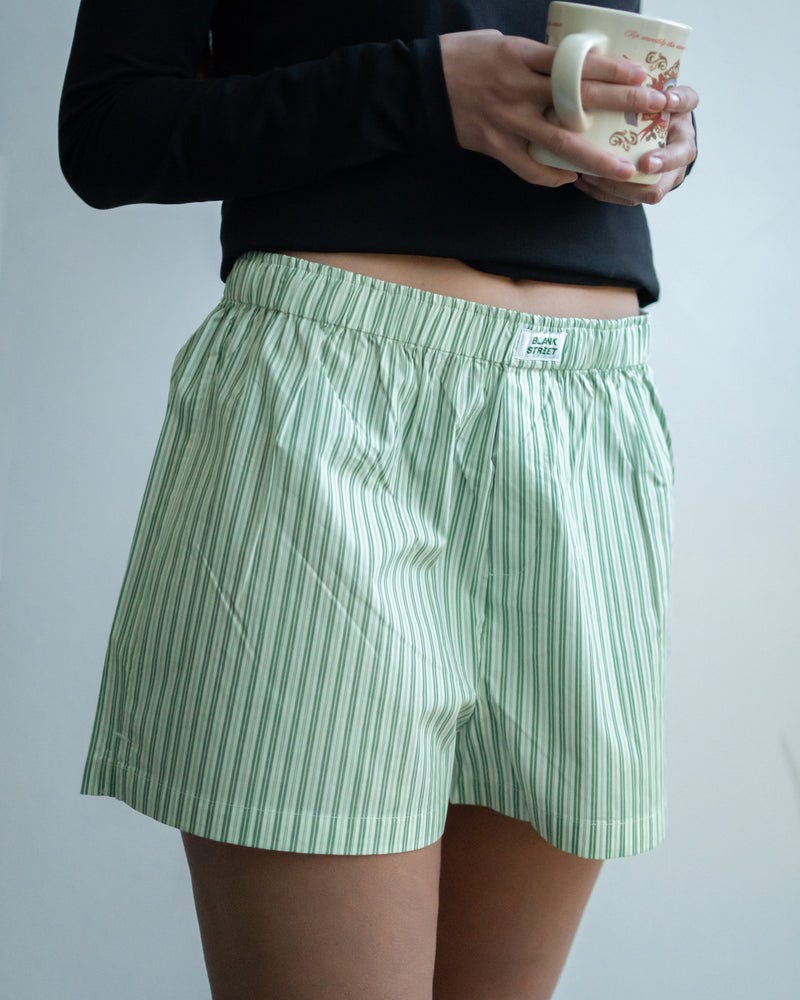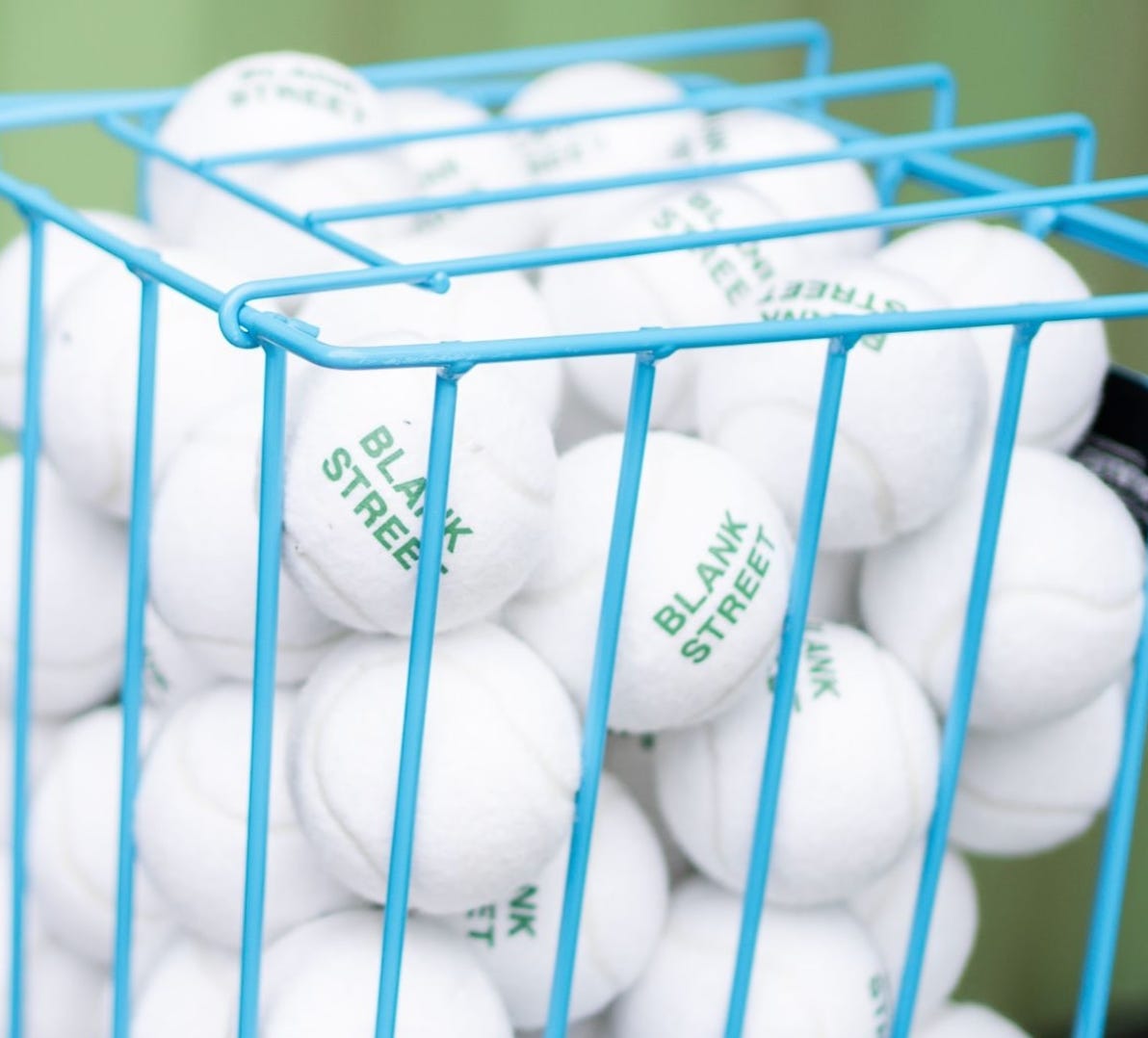does anyone else feel like we’re at peak merch? when exactly did branded merch move beyond trade shows and expos to become covetable?
merch is no longer just a throwaway promo item - a pen with a logo or a naff reusable coffee cup. It’s a status symbol. It’s social currency. It’s cool.
beyond the tote, customers are actually wearing their favourite brands- on their heads, hoodies, even Blank Street boxer shorts. The right merch makes consumers more than walking billboards; it fosters community, drives revenue, and can even be leveraged as an incentive. Done creatively, it also has the ability to create much coveted brand buzz, PR, and turns customers into advocates who proudly rep the brand.
Arthur Boyd, co-founder of Brand Stamp - the merch brand behind unforgettable drops for brands like Snapchat, Oatly, It’s Bagels and Blank Street - sums it up: “Merch is one of the best ways to grow a brand right now. It’s physical, it’s tangible, and it sticks around way longer than a digital ad.”
but does that mean your brand should do it?
Image Blank Street Boxer Shorts
merch as social currency
great merch doesn’t just promote a brand - it builds belonging. It’s that unspoken connection when you spot someone wearing the same cap - a quiet nod of mutual appreciation, sometimes even a hello to a stranger. People want to be part of something.
when I saw Olivia Wilde wearing the same Sweet Pickle Books cap I own, I felt instantly cool (yes I know that makes me uncool to admit!) It wasn’t about the logo; it was about what it represented - an IYKYK moment. And it’s the same when I spot someone in a coffee shop repping a brand I love on their t-shirt or I see an Erewhon hoodie and I think - yes, we both love ridiculously overpriced smoothies and health foods.
merch isn’t just an item; it’s a signal. A status symbol. A reflection of what you stand for - a wearable barometer for what you think is cool.
image: hat season with Sweet Pickle Books
meaningful design vs. forgettable junk
no one wants another flimsy tote bag that falls apart with their laptop inside.
“There’s been a huge shift in how brands approach merch,” says Arthur Boyd, co-founder of Brand Stamp. “It’s no longer about slapping a logo on a product and calling it a day. Brands are being way more creative and intentional, making merch that actually aligns with their identity and connects with their audience.”
Brand Stamp doubled its revenue last year by helping brands - from tech to food to fashion - create merch that feels exciting and original. The common thread: “They all see the value in great merch and want to create something that stands out.”
Amelia Christie-Miller, founder of Bold Bean Co, puts it bluntly in her LinkedIn post:
“If you're putting a logo on your merch, you're lazy.”
it’s a great point - great merch isn’t about visibility; it’s about creating something people genuinely want. Bold Bean Co’s bean bowl, designed for the perfect heat-retaining shape. No logo in sight sold out in 30 minutes and is instantly associated with the brand through colour and it’s practical use alongside their products. It’s intersting, creative and different but…
how creative do you need to go?
it depends on your goal. If you’re aiming for PR buzz and social engagement, you might want to think beyond a cap. Arthur Boyd points out:
“It’s not about creating something quirky for the sake of it. Brands need to be open to what’s possible and give themselves enough time to make their products perfect—not just settle for a ‘that’ll do’ attitude.”
He cites the Giggs x Oatly limited edition cake and custard kit (created by Brand Stamp), which drove buzz, engagement and endless write-ups in consumer and marketing press. Unexpected, nostalgic, interesting and with merch that people could invest in. It wasn’t just product - it supported the storytelling. (I love this write up here)
Victoria Boyd-Drysdale, co-founder of Brand Stamp, told me:
“The best merch isn’t just a repeat of what’s trending. It’s something unique that feels like your brand. The fear of failure can hold brands back, but those willing to push boundaries create the most impact.”
if you want to have a big impact, the team at Brand Stamp advise - “a great place to start is by thinking about a problem they’re currently facing and how merch could solve it.” Combining both practicality with smart design creates merch that stands out eg Nimbi the plastic-free razor brand, collaborated with the team to create a plastic-free body brush to elevate the shaving experience.
but if your goal is simply to align yourself with a classic product- like a cap or tote- it can still work. The key is how you position it: exclusivity, messaging, and its integration to your campaign - all play a role.
keeping it classic can still work
not every brand needs to reinvent the wheel - or in this case, the hoodie. Some of the best merch isn’t a groundbreaking new product, but an everyday item made desirable through brand positioning, community engagement, or clever execution.
take Refy’s cap from last summer - there’s nothing unique about the design it was white with the logo on the front, but it worked because they leveraged their brand’s cool factor, timed it for summer, and paired it with gorgeous campaign imagery (and I kept seeing the ad!) You could only get it if you spent over a certain amount, turning it into a coveted reward.
Papier took the same product but leaned into community engagement. Creating a “Paper Person” cap but made desirable by letting their audience vote on the colour and slogan. People resonated to describing themselves as a paper person and by the time it launched, demand was built in. But you couldn’t buy it. It was only available via events, for Papier team members, or through social media challenges/engagement - making it feel exclusive and meaning the cap “sold out” within a few days.
even The Financial Times were able to take a simple tote bag created by Merchery and make me want it! Their “My FT is Inside” slogan gave it a sense of intrigue and plays into the prestige of reading their salmon pink paper, while their “Thinking Cap” was playful with the logo subtly placed on the back. A clever touch that made it feel like a lifestyle item rather than a promotional freebie.
if you're going to stick to the classics (a tote, a cap, a hoodie), it needs a hook:
subtle slogans – a logo alone isn’t enough unless your brand name is very fun.
integrate into your brand experience – Ace Hotel’s hoodie giveaway if you book a room isn’t just free merch - it’s a tangible piece of their aesthetic and culture, reinforcing the hotel’s brand identity.
make it limited edition – If you really want to make merch desirable, scarcity matters. A limited run, exclusive drops, or event-only access makes an item feel more special. The psychology of “get it before it’s gone” turns merch into a collector’s item rather than a throwaway freebie.
the sustainability situation
merch is big business, but it’s also a big sustainability challenge. All brands need to be conscious of their environmental footprint, and cheap, mass-produced branded merch only adds to the problem.
those taking merch seriously are rethinking their approach:
producing items people will actually use (think: quality over quantity/solving a problem with the item)
ordering limited quantities (scarcity works)
sourcing responsibly (recycled materials, ethical production)
prioritising longevity (no one needs another flimsy tote bag)
thinking creatively – the best merch has unexpected details: branded tags inside caps, custom features made for the product.
plus, Victoria notes -
“The little details, the unexpected touches, the extra thought—those turn good merch into great, memorable merch.”
Thoughtful merch takes more effort than a bulk order of screen-printed tees. But brands thinking long-term see the payoff in loyalty and perception.
72% of consumers believe the quality of a promotional product is directly tied to the reputation of the company. (Source: PPAI)
think of it this way if you’re making cheap, forgettable merch, what does that say about your brand?
merch got so cool even the merch brands are cool
gone are the days of Fruit of the Loom and dodgy printed promo tees. Today’s merch creators - like Merchery and Brand Stamp- are building their own brand reputations, partnering with companies to craft high-quality, storytelling-driven products.
Merchery even launched a billboard campaign calling out bad employee merch, while Brand Stamp is gaining a reputation as a true creative partner, not just a vendor. It’s a cool evolution and indicative of where the trend for merch is going.
how do we think about Merch ROI?
once upon a time, merch success was measured in units given out, sales Now? It’s about advocacy. People don’t just wear merch - they talk about it, share it, and bring others into the fold.
Amelia puts it best:
“ROI isn’t measured in logo impressions anymore. It’s measured in people telling their friends ‘you need this bowl for your beans.’ In a world of targeted ads, genuine advocacy is marketing gold. “
Arthur adds:
“The best merch doesn’t just remind people of your brand—it becomes something they actively want to use, wear, or talk about. That’s when you know you’ve nailed it.”
that’s the shift: merch isn’t just marketing. It’s product. Done right, it’s a brand statement that speaks louder than any ad campaign - and costs less than a billboard.
final thoughts
Is merch the marketing boost your brand needs?
If it’s thoughtful, well-made, and something people genuinely want – absolutely. Ask your community what they’d like to see to really get buy-in. I like to think of it like this: will this be a cool vintage item in the future? If it’s just another throwaway promo item then invest elsewear to build your brand.
topline takeaway: how merch can support your brand?
drive revenue – cult-favorite drops that sell out in minutes.
build community - spotting someone in your favourite brand builds brand love
incentivise purchases – the Ace Hotel is offering hoodies with bookings; Refy gave away caps.
boost employee engagement – branded items that people actually want to wear builds connection.
create buzz – the exclusivity of a well-designed product can fuel PR and social engagement.
support events – Blank Street created fully branded paddles & tennis balls for their summer activation and Snapchat’s Snap school featured crochet Snapchat bags in their distinct shade of yellow, bringing the event together.









Great read Holly! I think the beauty space has done merch really well. Glossier’s recent black cherry collection launch comes to mind. In addition to makeup products, they created a limited edition black cherry combination lock which could be used on your suitcase or handbag. Checks all the boxes unique, nostalgic, and covetable.